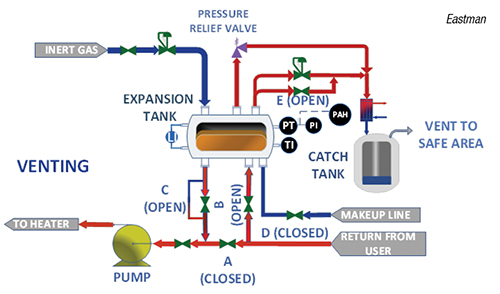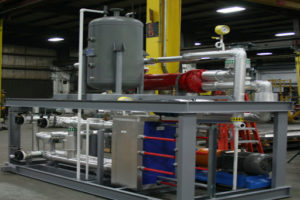A Comprehensive Guide to Selecting the Right Heat Transfer Equipments for Your Requirements
Choosing the ideal Heat transfer system is important for functional efficiency. Numerous systems provide to different needs, influenced by variables such as temperature array and liquid type. Comprehending the concepts behind Heat transfer, such as convection, radiation, and conduction, is crucial. Additionally, reviewing energy resources and maintenance techniques can affect long-term efficiency. A closer evaluation of these considerations discloses how to customize a system to particular demands. What should one prioritize in this facility decision-making process?
Comprehending Heat Transfer: Secret Concepts and Concepts
Heat transfer may appear like a straightforward idea, it incorporates a range of principles that are fundamental for reliable system design - DVS Heat Transfer Systems. Comprehending these principles is crucial for designers and designers who aim to maximize thermal performance in various applications. Conduction, as an example, includes the transfer of Heat via strong products, while convection describes the motion of Heat within liquids. Radiation, one more essential principle, explains how Heat can be transferred via electro-magnetic waves. Each of these mechanisms plays an essential duty in determining exactly how energy moves within a system. By thoroughly grasping these ideas, professionals can make educated choices, making certain that Heat transfer systems run effectively and fulfill the certain needs of their applications
Sorts Of Heat Transfer Equipments: An Introduction
Understanding the concepts of Heat transfer prepares for discovering the numerous types of Heat transfer systems offered. Heat transfer systems can be classified mostly right into 3 types: transmission, radiation, and convection. Transmission includes Heat transfer via strong products, depending on direct call in between particles. Convection, on the other hand, occurs in liquids (liquids and gases) where the motion of the liquid itself facilitates Heat transfer. Radiation entails the transfer of Heat through electromagnetic waves and does not call for a medium, allowing it to occur in a vacuum. Each kind of system has distinctive characteristics and applications, making it important for people and organizations to very carefully examine their specific demands when choosing one of the most appropriate Heat transfer remedy.
Applications of Heat Transfer Solutions in Numerous Industries
Heat transfer systems play a vital function across various markets, affecting performance and product high quality. In commercial manufacturing procedures, they facilitate exact temperature level control, while in food and beverage processing, they ensure security and conservation. Additionally, HVAC and environment control systems depend heavily on efficient Heat transfer to preserve comfy environments.
Industrial Manufacturing Processes

Many commercial manufacturing procedures rely greatly on effective Heat transfer systems to optimize efficiency and enhance product quality. In markets such as metalworking, Heat exchangers play a crucial duty in preserving excellent temperature levels during welding, casting, and forging. These systems ensure consistent Heat distribution, which is important for achieving wanted material homes. In the chemical production sector, Heat transfer systems promote exact temperature level control throughout responses, affecting yield and safety and security. Furthermore, in textile manufacturing, reliable Heat administration is necessary for coloring and finishing processes, influencing shade uniformity and textile high quality. By selecting ideal Heat transfer innovations, producers can enhance energy performance and reduce operational expenses, ultimately causing a more sustainable and competitive manufacturing setting.
Food and Beverage Handling
Efficient Heat transfer systems are similarly important in the food and beverage handling industry, where keeping ideal temperature levels is vital for food security and high quality. These systems play a vital role in procedures such as food preparation, sanitation, and pasteurization, guaranteeing that items are secure for usage and preserve their nutritional worth. Heat exchangers, for circumstances, efficiently move Heat between liquids, optimizing energy usage while lessening temperature fluctuations. In addition, refrigeration systems are fundamental for maintaining disposable products and prolonging service life. The option of Heat transfer modern technology directly impacts operational efficiency and product stability, making it necessary for food and drink producers to choose the proper systems customized to their specific processing demands. This careful choice ultimately adds to customer satisfaction and food security.

Heating And Cooling and Climate Control
While several industries depend on Heat transfer systems for effectiveness, A/C (Heating, Air Flow, and A/c) plays a vital duty in maintaining interior environment control across various setups. These systems utilize Heat transfer concepts to manage moisture, air, and temperature high quality, making sure comfort and security in household, commercial, and industrial environments. Effectively designed HVAC systems enhance energy performance, lower functional expenses, and decrease ecological influence. In commercial structures, as an example, effective climate control adds to employee efficiency and client contentment. In commercial applications, heating and cooling systems aid preserve optimal conditions for tools procedure and product preservation. Picking the right Heat transfer system is important for conference certain environment control demands and attaining total system efficiency.
Assessing Power Resources for Heat Transfer Equipments
In examining energy sources for Heat transfer systems, a comparison of sustainable energy alternatives and fossil fuel factors to consider is essential. Renewable resources, such as solar and wind, deal sustainable choices that can reduce environmental influence. Conversely, fossil gas remain common because of their established framework and power thickness, motivating a mindful assessment of both options.
Renewable Resource Options

Nonrenewable Fuel Source Considerations
Reviewing fossil gas factors to consider is essential for the effectiveness and sustainability of Heat transfer systems. Fossil fuels, such as all-natural gas, oil, and coal, are standard energy sources that supply significant Heat outcome, making them popular options for industrial and domestic applications. Their environmental their explanation effect, including greenhouse gas exhausts and source deficiency, raises worries. When selecting a heat transfer system, it is vital to analyze the accessibility, price, and governing variables connected with these gas. Additionally, the performance of fossil gas systems must be considered, as greater performance can reduce some ecological disadvantages. Inevitably, a well balanced method considering performance and sustainability can direct decision-makers towards the most ideal Heat transfer service for their specific requirements.
Variables to Take Into Consideration When Selecting a Warm Transfer System
Choosing an ideal Heat transfer system calls for careful consideration of various variables that can considerably affect efficiency and efficiency. One essential variable is the operating temperature range, which determines the materials and design suitable for the application. Furthermore, the kind of liquid used in the system-- whether gas or liquid-- influences Heat transfer effectiveness and compatibility. The system's size and ability should align with the certain demands of the procedure to stay clear of inadequacies. Power resource accessibility is likewise necessary, affecting operating expense and sustainability. The installment atmosphere, including area restrictions and availability for upkeep, plays a substantial function in system selection. Governing conformity and security requirements have to be taken into consideration to ensure the system satisfies all lawful demands.
Maintenance and Performance Optimization for Heat Transfer Equipments
Maintaining Heat transfer systems is crucial for ensuring optimal effectiveness and durability. Normal upkeep tasks, such as cleansing Heat exchangers and inspecting insulation, help stop efficiency losses due to fouling and thermal bridging. In addition, monitoring system criteria, including pressure and temperature level, permits early discovery of anomalies, minimizing downtime and expensive repair services. Implementing a preventative maintenance schedule can maximize performance and expand the life-span of elements. Upgrading to sophisticated control systems can boost functional efficiency by readjusting to varying tons and problems. By prioritizing upkeep and performance optimization, operators can accomplish lowered power intake, lower operational expenses, click to read more and boosted overall system dependability, eventually bring about far better source application and a much more sustainable operation.
Future Patterns in Heat Transfer Technologies
As markets increasingly focus on sustainability and energy performance, future fads in Heat transfer innovations are click here to read set to undertake substantial transformations. Developments such as sophisticated materials, including carbon nanotubes and nanofluids, guarantee improved thermal conductivity and efficiency. Additionally, the integration of renewable energy sources into Heat transfer systems is getting momentum, advertising eco-friendly remedies. Smart technologies, consisting of IoT sensing units, are expected to transform tracking and control, making it possible for real-time information analysis for enhanced performance. The development of modular and small systems will assist in less complicated setup and maintenance, providing to varied applications. These innovations show a shift in the direction of even more sustainable, efficient, and adaptable Heat transfer services, aligning with global power goals and ecological standards.
Frequently Asked Concerns
What Are the Environmental Influences of Heat Transfer Solutions?
The environmental influences of Heat transfer systems can include greenhouse gas exhausts, energy usage, and potential thermal contamination. In addition, incorrect disposal of inadequacies and materials can add to resource exhaustion and community disturbance.
How Do I Determine the Cost-Effectiveness of a Warmth Transfer System?
To determine the cost-effectiveness of a warmth transfer system, one should examine first prices, operational costs, upkeep needs, and power performance, comparing these factors versus the anticipated life expectancy and performance of the system.
Can Heat Transfer Solution Be Made Use Of in Residential Settings?
Heat transfer systems can undoubtedly be used in domestic settings. They give effective heating and cooling services, making homes more comfy while potentially lowering energy costs. Their adaptability permits various applications in domestic atmospheres.
What Safety And Security Regulations Put On Heat Transfer Equipments?
Safety and security guidelines for Heat transfer systems normally consist of standards on procedure, installment, and upkeep. Compliance with regional building codes, producer specifications, and industry criteria is necessary to guarantee efficient and risk-free system efficiency in numerous applications.
Exactly How Do Different Products Affect Heat Transfer Efficiency?

Transmission, for circumstances, entails the transfer of Heat with solid products, while convection refers to the activity of Heat within liquids. Recognizing the concepts of Heat transfer lays the groundwork for checking out the different types of Heat transfer systems offered. Heat exchangers, for instance, successfully move Heat in between liquids, maximizing power usage while decreasing temperature level variations. In assessing power resources for Heat transfer systems, a comparison of renewable energy alternatives and fossil gas considerations is essential. Steels, such as copper and aluminum, conduct Heat properly, whereas insulators like rubber and glass reduce down Heat flow.